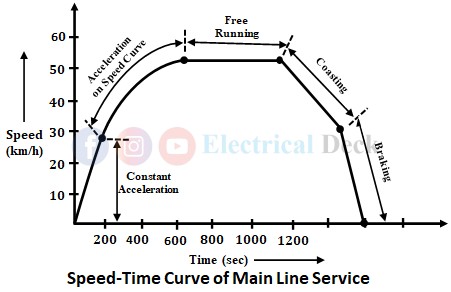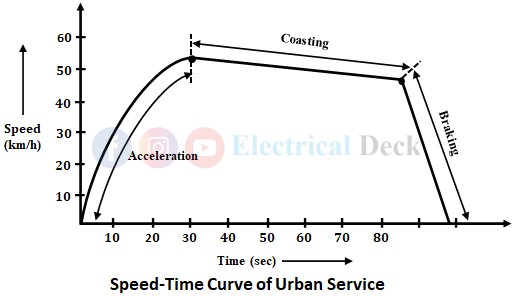What is Speed-Time Curve in Traction?
A curve plotted with time in seconds or minutes in the abscissa (x-axis) and speed in km/h as ordinate (y-axis) at different instants from start to stop of a train is known as the speed-time curve. In order words, a speed-time curve is a curve plotted between speed and time, taking speed on the vertical axis and time on the horizontal axis.
Uses of Speed-Time Curve :
The speed-time curve gives complete information about the motion of the train.- It gives the speed of the train at various instants after the start of the run.
- Its slope gives acceleration or retardation.
- The area between the curve and horizontal axis gives the distance covered by the train.
- If the resistance to the motion of the train is known then the energy required for propulsion can be easily calculated.
Therefore, by using speed-time curves the movement of the train and its energy consumption can be easily calculated. The speed-time curve is different for various types of services i.e., mainline service, sub-urban service, and urban service. The parameters of the speed-time curve change for different services. Let us see the speed-time curve of each electric traction service.
Speed-Time Curve of Main Line Service :
When the distance between two stations is more than 10 km then the traction service is called mainline service. The most important requirements of mainline service are high speed and minimum cost of the overhead structure. Acceleration and retardation are not so important in this service.
For this service, a single-phase ac system is best suited since the power can be distributed at a high voltage which in turn reduces the cost of the conductor and the number of substations required. Also, the initial, maintenance and operating costs of an ac system are less. The below shows the speed-time curve of the mainline service.
Constant Acceleration Period :
Before this period starts the train will be at rest position (assume the train is at a station). Now the train is propelled by giving acceleration and is maintained constant. This is obtained by maintaining constant current and voltage across the motor by cutting out the starting resistance.
Therefore tractive effort and acceleration remain constant in this period. The typical value of acceleration in constant acceleration period vary between 0.6 to 0.8 km/hr/sec.
Acceleration on Speed Curve Period :
In this period, the current and torque decrease with an increase in speed. It happens when full voltage is applied to the motor. This will cause a gradual decrease of acceleration until sufficient torque to maintain the motor is attained.
Though the train accelerates, the acceleration decreases with an increase in speed and finally becomes zero at a speed at which the tractive effort developed by the motor becomes exactly equal to the resistance to motion of the train.
Free Running Period :
At the end of the accelerating speed curve period, the train attains maximum speed. During the free-running period, the train runs with constant speed which is attained in the accelerating period. The power drawn in this period is constant and thus speed also remains constant.
Coasting Period :
During this coasting period, the power supply to the motor is switched OFF and the train is allowed to run on its own momentum. Thus the speed of the train starts decreasing due to resistance to its motion offered by wind and friction at the wheels. The rate of decrease in speed during this period is known as coasting retardation.
Braking Period :
In the braking period, brakes are applied to the wheels of the train to bring it to rest i.e., to stop the train when it reaches the next station. The typical value of retardation is 1.5 km/hr/sec.
Speed-Time Curve of Sub-Urban Service :
If the distance between two stations is in the range of 1 to 7 kilometers, then such type of traction service is known as sub-urban service. In sub-urban service, the free-running period does not exist. The coasting period in this type of service is comparatively long. The important requirements of suburban service are,
- Rapid acceleration and retardation are required due to frequent starting and stopping.
- Motors should work without being affected by voltage fluctuations.
- No interference with communication lines.
For the above requirements, a dc system is more suitable for suburban service. The advantages of a dc system are,- Less energy consumption.
- For the same torque, the current required in a dc system is less than that in an ac system.
- DC motor and locomotive equipment is lighter in weight, has less initial and maintenance cost, and is more efficient.
But the drawback of a dc system is due to the low voltage distribution, the current required is high. So, the cross-section of the conductor is large and the spacing between substations is less i.e., more substations are required. Substations are costly and converting machinery is needed. But some of the drawbacks can be overcome by using a single-phase ac to dc traction system.
The speed-time curve for a sub-urban service consists of three regions, which are explained below.
Acceleration Period :
The train at a standstill position is accelerated by the motor for its motion. For sub-urban service, high acceleration (between 1.5 to 4 km/hr/sec) is maintained for attaining rapid speeds. By varying starting resistance, the value of current is limited and the voltage is gradually increased until a high tractive effort is obtained which in turn increases the acceleration.
Coasting Period :
As the distance between two stations is small as compared to mainline service, the free-running period is absent in sub-urban service. As soon as the train attains maximum speed, the power supply is turned off. From there, the train will be in motion because of its momentum. During the coasting period as the supply is shut down, the speed of the train decreases due to resistance.
Braking Period :
In the braking period, the train is brought to a standstill position by applying brakes. In this period, high retardation of about 3 to 4 km/hr/sec has to be maintained by the train.
Speed-Time Curve of Urban Service :
In this service, the distance between stations is in the range of 0.75 km to 1 km. Therefore, the time of the run is very small. So, acceleration and retardation values must be sufficiently high so has to maintain a high average speed. The below shows the speed-time curve of urban service.
The speed-time curve of urban service will be same as sub-urban service with no free-running period. But the coasting, acceleration, and retardation periods are small in urban service as the distance between stations is too small. The values of acceleration, retardation and coasting retardation are in the range of 1.5 to 4 km/hr/sec, 3 to 5 km/hr/sec, and 0.15 km/hr/sec respectively.
Speed-Time Curve of Metro Service :
This system is used mostly for transportation within a city. It is a convenient, fast, efficient, comfortable, and affordable mode of urban transport. DC motors or three-phase induction motors are used for the metro that goes above the ground level. Linear induction motors are used for underground metros. The acceleration and retardation values of metro service lie in the range of 2.16 to 3.16 km/hr/sec.
Comparison Between Various Traction Services :
| Type of Service | Acceleration in kmphps | Retardation in kmphps | Maximum Speed in kmph | Distance Between Stations | Remarks |
|---|---|---|---|---|---|
| Main Line | 0.6 to 0.8 | 1.5 | 160 | More than 10km | Free running and coating periods are long. Acceleration and retardation periods are small. |
| Sub-urban | 1.5 to 4.0 | 3 to 4 | 120 | 1 to 8km | No free-running period, long coating period. |
| Urban | 1.5 to 4.0 | 3 to 4 | 120 | 1 | No free-running period, small coating period. |



